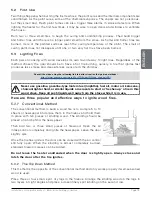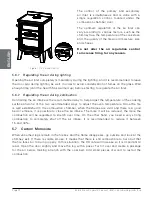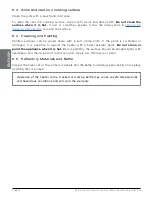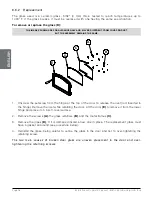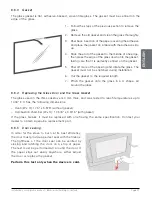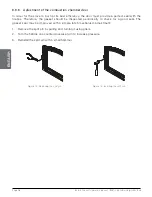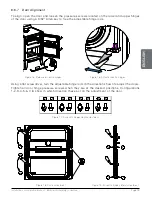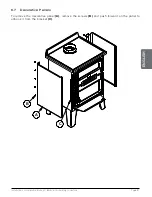
Page 16
Installation and operation manual - Bistro woodburning cookstove
ENGLISH
4. Combustibles
Good firewood has been cut to the correct length for the stove, split to a range of sizes and
stacked in the open until its moisture content is down to 15% to 20%.
DO NOT BURN:
•
GARBAGE;
•
LAWN CLIPPINGS OR YARD WASTE;
•
MATERIALS CONTAINING RUBBER, INCLUDING TIRES;
•
MATERIALS CONTAINING PLASTIC;
•
WASTE PETROLEUM PRODUCTS, PAINTS OR PAINT THINNERS, OR ASPHALT
PRODUCTS;
•
MATERIALS CONTAINING ASBESTOS;
•
CONSTRUCTION OR DEMOLITION DEBRIS;
•
RAILROAD TIES OR PRESSURE-TREATED WOOD;
•
MANURE OR ANIMAL REMAINS;
•
SALT WATER DRIFTWOOD OR OTHER PREVIOUSLY SALT WATER SATURATED
MATERIALS;
•
UNSEASONED WOOD; OR
•
PAPER PRODUCTS, CARDBOARD, PLYWOOD, OR PARTICLE BOARD. THE
PROHIBITION AGAINST BURNING THESE MATERIALS DOES NOT PROHIBIT
THE USE OF FIRE STARTERS MADE FROM PAPER, CARDBOARD, SAW DUST,
WAX AND SIMILAR SUBSTANCES FOR THE PURPOSE OF STARTING A FIRE
IN AN AFFECTED WOOD HEATER.
•
BURNING THESE MATERIALS MAY RESULT IN THE RELEASE OF TOXIC FUMES
OR RENDER THE HEATER INEFFECTIVE AND CAUSE SMOKE.
4.1 Tree Species
The tree species the firewood is produced from is less important than its moisture content. The
main difference in firewood from various tree species is the density of the wood. Hardwoods are
denser than softwoods.
Note that hardwood trees like oak, maple, ash and beech are slower growing and longer lived
than softer woods like poplar and birch. That makes hardwood trees more valuable. The advice
that only hardwoods are good to burn is outdated. Old, leaky cast iron stoves wouldn’t hold a
fire over e longer period of time unless they were fed large pieces of hardwood. That is no longer
true.
Summary of Contents for DB04815
Page 2: ......
Page 38: ...Page 38 Installation and operation manual Bistro woodburning cookstove ENGLISH ...
Page 63: ...NOTES ...


















